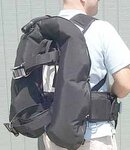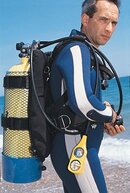KevinNM
Contributor
So you have concluded that bondage wings suck. What are you planning on doing about it?
Welcome to ScubaBoard, the world's largest scuba diving community. Registration is not required to read the forums, but we encourage you to join. Joining has its benefits and enables you to participate in the discussions.
Benefits of registering include
Anyhow it sounds like a wing is something to try. Thanks to all the helpful people.


If you cant understand that the loose end expands and displaces more water because there is no force holding it back like the other side, then you should get out your junior high school books.
Or admit that you were schooled here in Advanced Scuba Discussion.
Like when everyone said I couldn't teach students off of their knees for the entire class? Often, when you follow the masses, the 'm' is silent.One thing I've learnt reading these kind of threads on SB is - if you find one guy arguing against everyone else, chances are the one guy is wrong.
Thanks for your kind words!Pete, while I think the shape of BC can effect performance in various orientations your point about becoming more neutrally buoyant is spot on. That is the most effective strategy the OP could employ to solve their issue.
I agree with the first part, but not the second. The search for the absolutely smallest BC is a fool's errand and can lead to not having enough lift when you need it most. No matter how big your bladder, you can still get your Scuba unit balanced to the point so you don't need much air in it. You might get some tacoing if the wing is really over sized, but there are ways to compensate for that, including bungees. The danger of bondage wings lie mostly in a few people's overactive imagination and not in reality.Once you are close to neutrally buoyant, the amount of air you need to add to a BC is minimal, so you can look at using a smaller one next time you buy. When you look at a smaller one you can also look at design considerations such as jacket, donut, horseshoe. But the first step is buoyancy.
It's all about the breathing, ain't it? Throwing gear at a training issue, even if it's the revered BP&Wing, is frustrating when it doesn't work out. FWIW, keeping the COG is easier if there's not much of a bubble shift. The closer you are to zero air in your BC and even your drysuit will enable that. The first is easy but doing that to the second is counter productive. Air=warmth.I had to work quite hard to figure out how to adjust my breathing when I flipped upside-down and lay on my back.

